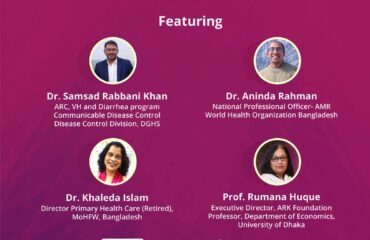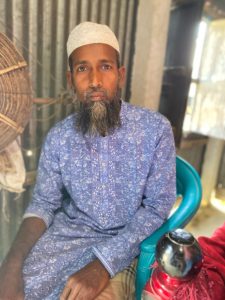When asked where he goes to seek healthcare, he reluctantly replies that he “never needs to go to a doctor” and that the compounder at the nearby drugstore gives him all the medicines he needs for minor ailments like a headache or a stomach flu. Rahim has neither felt the necessity to measure his blood pressure nor has he ever checked his blood glucose level. For him, even though he has not engaged in any productive activity for years, visiting a UPHCC for a general health check-up is a tedious use of his time.
After all, why would he? “I am not in any pain, and I don’t have any difficulty in doing what I do every day,” explains Rahim.
On the other hand, Foyez’s (35) family has been enlisted as “extreme poor” during a survey conducted a few years ago by the UPHCC health workers, and they now have a “Red Card” as a ticket to free healthcare for the whole family.
He gladly described that he didn’t have to pay for his wife’s ANC check-ups, vitamins, and supplements; the delivery was also conducted at “Nagar Matrisadan” (the delivery center under the urban primary healthcare service delivery project) absolutely free of cost; otherwise, a rikshawpuller like himself would have to suffer very much to manage the medical cost.
When asked how many times he himself has taken free services from the UPHCC using the Red Card, he smiled and said that the center is mostly for pregnant women and newborns. Although he had brief episodes of illness in the past few months—a fever, a headache that expanded to his neck and shoulders, restlessness, and discomfort in his chest—he either bought himself some paracetamol from a local drugstore or did nothing about his ill health. If he goes to visit a doctor, he would have to wait for a long time in the queue.
A long waiting time means lost income, and not everyone can afford it. Especially a rikshawpuller with 3 children to look after.
Men’s health as an issue has begun to attract more specific attention as growing evidence emerges of differential epidemiological trends between men and women, particularly with respect to men’s premature mortality from non-communicable diseases (NCDs) and morbidity linked to poor health-seeking behaviors, mental health, and violence.
Several global public health research bodies have stated that in almost every country of the world, men are more likely than women to die before age 70, and data from the World Health Organization (WHO) suggest that approximately 52% of all NCD deaths worldwide (2018) occurred among men.
The probability of men dying from cardiac ischemic diseases is 75% higher compared with women. However, 36% of deaths in men are preventable, compared with 19% in women. Why then are men underutilizing the available healthcare services?
Research suggests that gender and society’s perception of masculinity and men’s role in a family and community have big roles to play in men’s health. Nevertheless, the pattern of urban poor men’s health seeking and priorities of the urban healthcare service delivery projects in Bangladesh do leave questions about the inclusiveness of the system.
Men’s health in a system that prioritizes women
Bangladesh has a rather complicated urban health system. Considering the inadequate health workforce of the Local Government Division (LGD), the Ministry of Local Government (MoLGRD), who is responsible of providing primary healthcare to the urban population, has launched several healthcare delivery projects, mostly through contracting out service delivery to NGOs.
The ADB funded Urban Primary Healthcare Service Delivery Project (UPHCP) was launched in 1998, in order to provide general healthcare and comprehensive reproductive healthcare to the urban population, with special emphasis on the urban poor.
Although UPHCP, along with most other healthcare projects under MoLGRD, are bound to provide primary care to the entire urban population irrespective of their socio-demographic traits, maternal and child health (MCH) and sexual and reproductive health (SRH) services have traditionally been the main focus of the projects.
For needs assessment of CHORUS Bangladesh, a project which is designed around strengthening UPHCP for providing NCD care, we had to explore not only the project documents that define the priorities of this project but also the approach and activities of the healthcare managers and providers.
The NGOs are given certain service delivery targets that they are bound to meet in order to remain in the role of providers; targets that are mostly revolving around MCH and SRH – number of ANC visits, number of deliveries, number of family planning methods implemented per annum, etc.
There are no targets that prioritize adult men’s health per se, unless a female counterpart’s reproductive health is linked to the health outcome of the man. Literature suggest that the high rate of maternal and child mortality and morbidity related to reproductive health before and during the MDG period might have influenced funders and the government to focus on MCH and SRH.
Consequently, the field workers and paramedics running the satellite clinics in each project area direct their services and community engagement towards increased utilization of services by women and adolescent females. However, healthcare managers state that they have always kept their doors open for men. “We have even hung banners to invite men to the primary healthcare centers. Yet, we only get less than 20% male patients at the facilities,” said the Project Manager of one of the NGOs implementing UPHCP under Dhaka North City Corporation (DNCC).
To provide insight about why the trend has been set like that, project manager of another NGO said, “I think since the Comprehensive Reproductive Healthcare Centers (CRHCC) and Primary Healthcare Centers (PHCC) in each area are run by the same NGO, men have this presumption that the NGO clinics are for women.”
She further stated, “Almost all of our healthcare providers, including the health counsellors, are female. The men in our target population might not be comfortable consulting with female providers, as the urban poor communities still hold prejudices.” From interviews of healthcare providers and clients, we know that the community health workers play a big role in bringing ANC and family planning clients to the clinics, but they do not engage as such with adult men (or women) to bring potential or diagnosed NCD patients to the PHCCs.
Our experience says that urban primary healthcare system at present is not prioritizing men’s health. On the other hand, research has shown that healthcare utilization by men increases at each higher level of care (from primary to secondary and tertiary hospitals), which suggests that men seek care when the severity of their health issues require advanced interventions.
To improve men’s healthcare-seeking behaviors, researchers and practitioners will need to consider individual, economic, and social determinants of men’s healthcare-seeking behaviors and pertinent barriers toward improvement.
The urban health system in Bangladesh needs to be sensitized to the healthcare seeking patterns and difficulties of men so that the system can be made more acceptable for men in need.
Community health workers and primary care providers need to be trained and equipped to not only recognize the needs of adult men but to also provide preventive care, i.e. screening, counselling and health education about risk factors, to improve health seeking behavior of this vulnerable group.
Author: Maisha Ahsan Momo, Research Assistant, ARK Foundation




